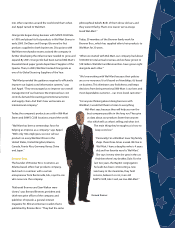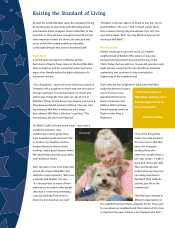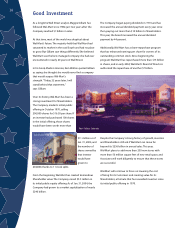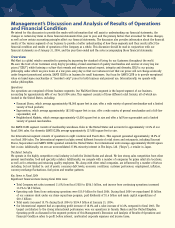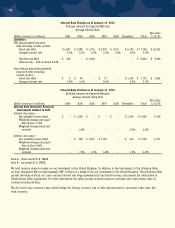Walmart 2004 Annual Report Download - page 20
Download and view the complete annual report
Please find page 20 of the 2004 Walmart annual report below. You can navigate through the pages in the report by either clicking on the pages listed below, or by using the keyword search tool below to find specific information within the annual report.
Management’s Discussion and Analysis of Results of Operations
and Financial Condition
We intend for this discussion to provide the reader with information that will assist in understanding our financial statements, the
changes in certain key items in those financial statements from year to year, and the primary factors that accounted for those changes,
as well as how certain accounting principles affect our financial statements. The discussion also provides information about the financial
results of the various segments of our business to provide a better understanding of how those segments and their results affect the
financial condition and results of operations of the Company as a whole. This discussion should be read in conjunction with our
financial statements as of January 31, 2004, and the year then ended and the notes accompanying those financial statements.
Overview
Wal-Mart is a global retailer committed to growing by improving the standard of living for our Customers throughout the world.
We earn the trust of our Customers every day by providing a broad assortment of quality merchandise and services at every day low
prices (“EDLP”) while fostering a culture that rewards and embraces mutual respect, integrity and diversity. EDLP is our pricing
philosophy under which we price items at a low price every day so that our Customers trust that our prices will not change erratically
under frequent promotional activity. SAM’S CLUB is in business for small businesses. Our focus for SAM’S CLUB is to provide exceptional
value on brand-name merchandise at “member’s only” prices for both business and personal use. Internationally, we operate with
similar philosophies.
Operations
Our operations are comprised of three business segments. Our Wal-Mart Stores segment is the largest segment of our business,
accounting for approximately 68% of our fiscal 2004 sales. This segment consists of three different retail formats, all of which are
located in the United States, including:
• Discount Stores, which average approximately 98,000 square feet in size, offer a wide variety of general merchandise and a limited
variety of food products;
• Supercenters, which average approximately 187,000 square feet in size, offer a wide variety of general merchandise and a full-line
supermarket; and
• Neighborhood Markets, which average approximately 43,000 square feet in size and offer a full-line supermarket and a limited
variety of general merchandise.
Our SAM’S CLUB segment consists of membership warehouse Clubs in the United States and accounts for approximately 13.5% of our
fiscal 2004 sales. Our domestic SAM’S CLUBs average approximately 127,000 square feet in size.
Our International segment consists of operations in eight countries and Puerto Rico. This segment generated approximately 18.5% of
our fiscal 2004 sales. The International segment includes several different formats of retail stores and restaurants, including Discount
Stores, Supercenters and SAM’S CLUBs operated outside the United States. Our international units average approximately 85,000 square
feet in size. Additionally, we own an unconsolidated 37.8% minority interest in The Seiyu, Ltd. (“Seiyu”), a retailer in Japan.
The Retail Industry
We operate in the highly competitive retail industry in both the United States and abroad. We face strong sales competition from other
general merchandise, food and specialty retailers. Additionally, we compete with a number of companies for prime retail site locations,
as well as for attracting and retaining quality employees. We, along with other retail companies, are influenced by a number of factors
including, but not limited to: cost of goods, consumer debt levels, economic conditions, customer preferences, employment, inflation,
currency exchange fluctuations, fuel prices and weather patterns.
Key Items in Fiscal 2004
Significant financial items during fiscal 2004 were:
• Total Company net sales increased 11.6% from fiscal 2003 to $256.3 billion, and income from continuing operations increased
13.3% to $8.9 billion;
• Operating cash flows from continuing operations were $15.9 billion for fiscal 2004. During fiscal 2004 we repurchased $5 billion
of our common stock under our share repurchase program, paid dividends of $1.6 billion and made capital expenditures of
$10.3 billion;
• Total assets increased 10.7% during fiscal 2004 to $104.9 billion at January 31, 2004;
• Our International segment had an operating profit increase of 18.6% and a sales increase of 16.6% compared to fiscal 2003. The
largest contributors to the strong international performance were our operations in Canada, Mexico and the United Kingdom.
Operating profit as discussed in the segment portions of this Management’s Discussion and Analysis of Results of Operations and
Financial Condition refers to profit before interest, unallocated corporate expenses and income taxes;
18



